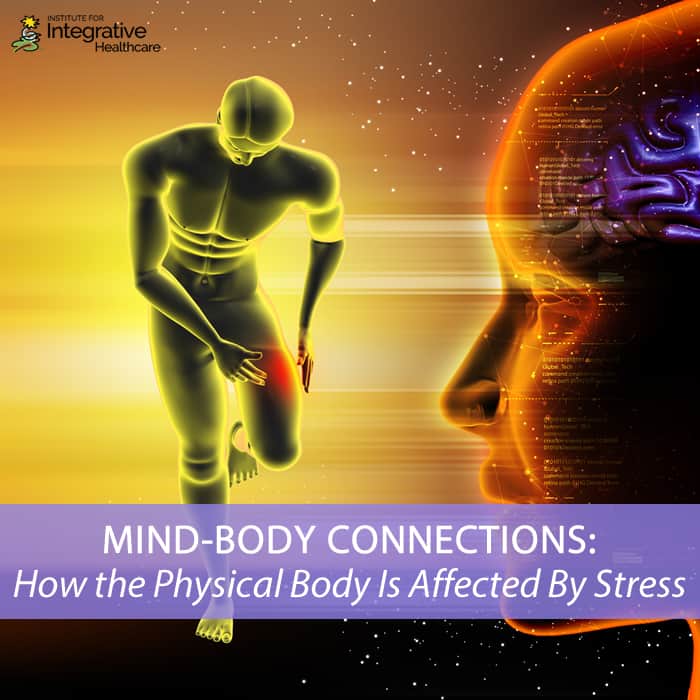

There is much talk in the news about the mind-body connection, specifically about how our emotions impact our physical health. This mind-body connection can be detrimental when long term stress leads to negative physical symptoms such as heart disease. But the mind-body connection can also be a positive thing – like when a cancer patient is able to reduce pain significantly through meditation.
Emotional stress causes physiological responses in the body via the nervous and hormonal systems, kicking off a cascade of reactions that can eventually lead to “disease” ranging from mild digestive problems to cancer. As massage therapists, it is important to understand that clients undergoing long term, chronic stress or who are going through periods of acute, severe stress may be experiencing physiological symptoms as well as emotional upset.
In order to fully understand the mind-body connection, the communications between our emotional experiences and our physical bodies, we need to have a basic understanding of the nervous system and how the physical body interacts with our emotions.
Nervous System
The body’s nervous system is comprised of the brain, the spinal cord and nerves that run throughout the body, branching out from the spinal column, between the vertebrae. Let’s take a minute to review the divisions of the nervous system and how they work together.
- The central nervous system (CNS) consists of the brain and the spinal cord, which act to integrate sensory information, motor control and signals from the brain to make decisions. The CNS is also responsible for consciousness, including language and emotion.
- The peripheral nervous system (PNS) includes everything outside of the brain and spinal cord. The PNS is made up of the nerves that run throughout the body, both sensory and motor control, including the spinal nerves and pain receptors.
- The somatic nervous system (SNS) is a subsection of the peripheral nervous system that is responsible for muscle control.
- The autonomic nervous system (ANS) is another subsection of the peripheral nervous system that controls the involuntary processes and muscle contractions such as breathing, heart rate and glandular production (hormones).
- The sympathetic nervous system is a subsection of the autonomic nervous system which makes up the “fight or flight” response to stress – direction of blood flow to the extremities, the uptick of heart rate and adrenaline, and the decrease in digestion.
- The parasympathetic nervous system controls the body’s “rest and digest” actions, when the body can recover, digest food and make repairs to injuries. The heart rate is decreased and breathing becomes easier.
When the person becomes aware of some threat – real life and death or perceived social threat – the sympathetic nervous system kicks in, heart rate and breathing increase, adrenaline floods the bloodstream and the body prepares to run for its life. This can impact the emotional state, and the emotional state, in turn, can impact the nervous system. When the emotional status of the person is the stimulus for the fight or flight response, it creates a feedback loop that can result in long term elevated heart rate, elevated breathing rate and exhaustion of the adrenal glands as the body is flooded long term with adrenaline. Not only that, but as the body is unable to return to the rest and digest stage, it does not repair itself on the cellular level and digestive diseases become common.
Understanding the body’s systems and how the physical body can – and is – affected by sensory input, both emotional and physical, we can see how stress in various forms can impact our physical health.
What Is Stress?
Stress can be defined in many ways, and depends on how it is perceived by the individual. Stress to one person may be simply getting through their day: getting the kids off to school with their lunches and homework, getting to work on time themselves, arriving home to meet the school bus on time, and getting dinner ready for the family. Or, stress might be financial – making enough money to support the family.
Stress can also be more intense, such as dealing with a horrible boss or the looming threat of layoffs at work. Stress can be elevated even more for those who live in areas of the world with unstable political conditions where war may break out any time, or may have already broken out. Most of us in the U.S. all experienced intense stress, often classified as trauma, around the time of September 11th, when the towers fell. Imagine the stress experienced by refugees fleeing extreme poverty, or seeking political asylum from horrendous conditions.
Stress can be anything that upsets us, makes us feel uneasy, or makes us nervous and afraid. Just because we are not facing what others consider a traumatic event doesn’t mean that we are not experiencing stress in our own lives. Our bodies do not fully understand the difference between a fight or flight response to war and a fight or flight response to racing to catch a cab! To our physical body, both result in the same response – a flood of adrenaline – and when these things go on long term, we begin to pay the price with our physical health.
Massage to Combat Stress
Massage can be an excellent tool in reducing the physical reactions to stress because it aids in reducing the physiological responses.
Massage promotes:
- Slower, deeper breathing
- Improved sleep
- Lowered heart rate
- Reduced hormones associated with stress (adrenaline) and allowing the body to return to the “rest and digest” state of being
Recommended Study:
Ayurvedic Massage Fundamentals
Cardiopulmonary Health and Illness
Chronic Pain Management
Health Maintenance – Body & Mind
Integrative Massage: Spirit
Psychology of the Body
The Mind/Body Connection











